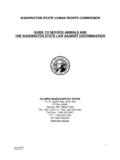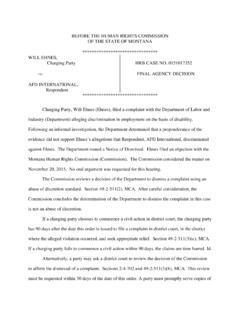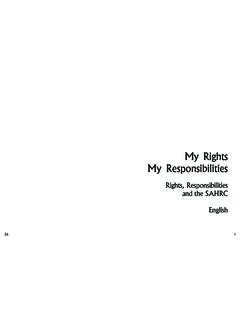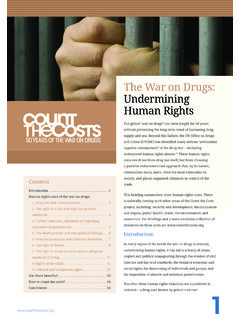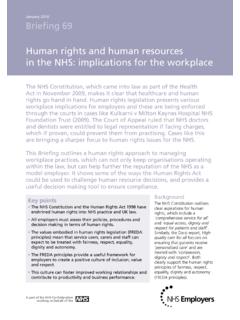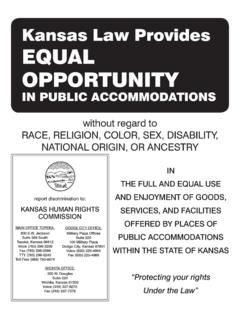Transcription of WASHINGTON STATE HUMAN RIGHTS …
1 1 Service animals October 2013 WASHINGTON STATE HUMAN RIGHTS commission GUIDE TO SERVICE ANIMALS AND THE WASHINGTON STATE LAW AGAINST DISCRIMINATION OLYMPIA HEADQUARTERS OFFICE 711 S. Capitol Way, Suite 402 PO Box 42490 Olympia, WA 98504-2490 TEL: 360-753-6770 - FAX: 360-586-2282 Toll Free: 1-800-233-3247 TTY: 1-800-300-7525 Se Habla Espa ol 2 Service animals October 2013 Service Animals and the WASHINGTON Law Against Discrimination The WLAD includes provisions prohibiting discrimination against persons with disabilities who use a service animal to assist them with the disability.
2 RCW defines a dog guide as a dog that is trained for the purpose of guiding blind persons or a dog that is trained for the purpose of assisting hearing impaired persons. RCW defines service animal as an animal that is trained for the purpose of assisting or accommodating a disabled person s sensory, mental, or physical disability. Service animals are utilized by persons with a variety of disabilities and in many different ways. Service animals may lead blind people or serve as the ears of a deaf person. They may also carry and pick up items, be used for balance, and provide warnings of impending seizures or low blood sugar.
3 Service animals may allow persons with anxiety disorders, PTSD or other emotional illnesses to function in society, by alerting their handlers to avoid anxiety triggers, by recognizing and blocking behaviors, or by stimulating the person to snap back to a conscious STATE . Service animals can remind handlers that it is time to take medication, and can summon help in the case of fainting or a seizure. The ways in which persons with disabilities use service animals are growing and evolving as we discover additional ways in which animals can be utilized by persons with disabilities.
4 Service animal laws in WASHINGTON are complex due to the intersection of STATE and federal law: there are different rules for places of public accommodation generally, for food establishments in particular, and for housing. Training WLAD clearly defines a service animal as being trained . Training itself is not defined, and there is no requirement that the animal have a certain type of training, that the animal be certified, or that it be trained by a particular person or by a person having certification. Court cases have determined that the training needs to be more than obedience training or positive reinforcement that are given to family pets.
5 A service animal must have training that sets it apart from a family pet; the service animal must be trained to engage in specific actions or tasks to assist its handler with a disability. This training requirement often eliminates emotional support animals , therapy dogs , and comfort animals from the definition of service animal. Before determining that an animal falls into one of these categories and excluding the animal, an inquiry should be made into what the 3 Service animals October 2013 animal is trained to do. However, if you are in a housing situation, federal law applies, because it has a more expansive definition that looks upon certain animals as reasonable accommodations for persons with disabilities, with no training requirement.
6 Please see Housing below for more information Service animals in places of public accommodation RCW prohibits discrimination in a place of public accommodation due to the use of a trained dog guide or service animal by a disabled person. WAC 162-26-130 requires fair service in a place of public accommodation regardless of the use of a trained dog guide or service animal by a disabled person as well as because of the disability itself. (Internal quotations omitted.) Service animals must be allowed into all areas of a place of public accommodation where the general public is allowed this includes dining and eating areas, restrooms, and areas where food is sold.
7 A place of public accommodation cannot request that the service animal be removed unless it creates a risk of harm. This risk must be actual, and cannot be speculative or based on a fear of dogs. In addition, if an animal exhibits disruptive, poor or unsanitary behavior, it would not be considered a trained service animal, and can be removed. Questions a business can ask: First a business can ask if the animal is a pet. If the animal is a pet, the business can exclude the animal. If the handler answers that the animal is a service animal, the business can proceed to a second question Second, the business can ask a task or training question, such as, What is this animal trained to do for you?
8 The answer to this question will determine if the business needs to allow the animal or if it can exclude the animal. - If the handler refuses to answer, the animal can be excluded. - If the handler discloses their disability, but refuses to disclose what the animal is trained to do for them, the animal can be excluded. - If the handler provides documentation or certification that the animal is a service animal, but neither the documentation nor the handler can explain what the animal is trained to do, the business can exclude the animal. (There is no STATE or federal service animal registry or certification process, so such documentation has no legal meaning and is often purchased on the Internet.)
9 4 Service animals October 2013 - If the handler answers only that the animal can sit, stay, lie down, come when called, or do something else related to obedience and good manners, this does not indicate the animal is trained to provide services for a disability, and the animal can be excluded. - If the handler answers that the animal makes them feel better, helps them calm down, eases their depression, or something similar, this would indicate that it is the animal s presence alone that helps the handler, and that the animal is not trained to do a task or provide a service. Because the animal does not meet the training requirement, the business can exclude the animal.
10 - If the handler answers that the animal is trained to guide them, help with balance or mobility, alert them to a condition (either physical or situational), pick up or carry items, remind them to take medication, get help, stabilize them during a seizure, redirect their attention from a trigger, or do some other task or provide some service that the person is unable to do themselves or helps with a disability, then the animal is a trained service and must be allowed. Points to keep in mind: - Service animals are not pets, so a no pets policy does not apply. - A business cannot charge a fee for the service animal.

